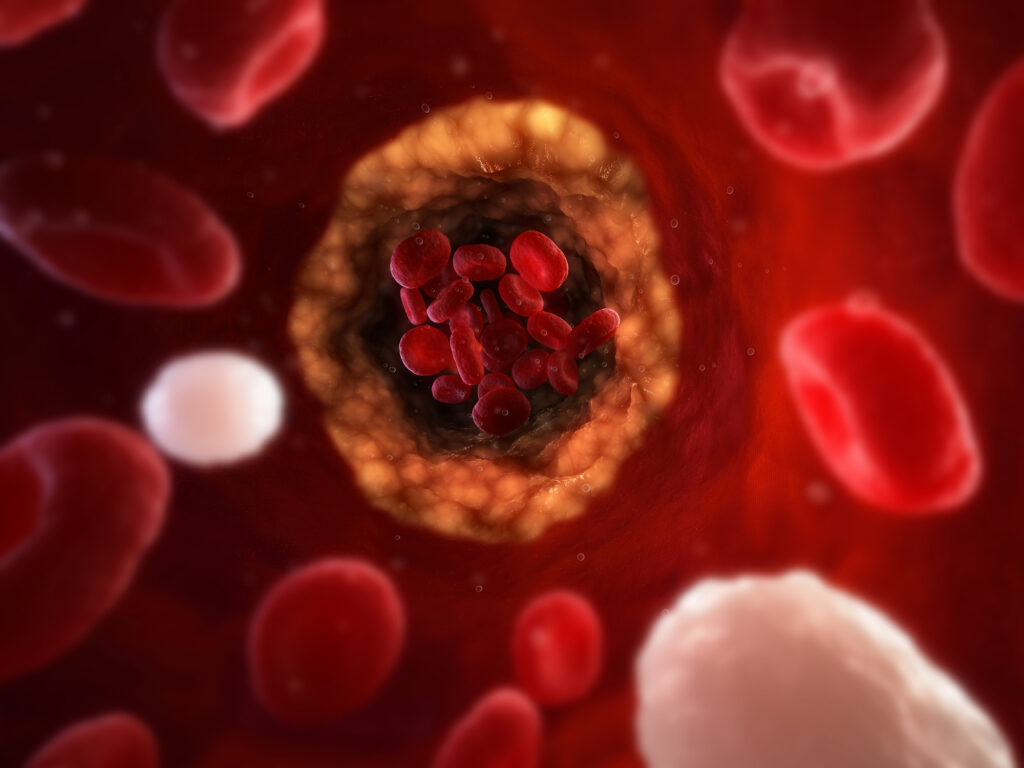Atherosclerosis is a condition that affects millions of people worldwide, often without warning. It plays a central role in the development of both heart disease and stroke, two of the leading causes of death and disability. Understanding what atherosclerosis is, who is most at risk, and the importance of early screening can significantly affect long-term health outcomes.
What is Atherosclerosis?
Atherosclerosis refers to the buildup of plaque, composed of cholesterol, fatty substances, calcium, and other materials, inside the walls of arteries. Over time, this buildup can narrow arteries and restrict blood flow to vital organs such as the heart and brain. If a plaque ruptures, it can trigger the formation of a blood clot, leading to a heart attack or stroke.
Often called a silent disease, atherosclerosis can develop slowly over many years without causing symptoms until a major cardiovascular event occurs.
Why is Atherosclerosis Important?
Atherosclerosis is the underlying cause of most cardiovascular (heart) and cerebrovascular (brain) events. Consider the following:
Heart disease remains the leading cause of death globally. This is the main reason why Radence is focused on it as a key area from the beginning.
Stroke is the second leading cause of death worldwide and a major cause of long-term disability. The risk of confounding health issues after a stroke is multiplied.
Many individuals with advanced atherosclerosis experience no symptoms until a heart attack or stroke happens. In fact, statistics from the Barnes-Jewish Hospital show that about 70% of people who have a stroke were asymptomatic before.
The ability to detect and manage atherosclerosis early can prevent these life-altering events and significantly improve both quality of life and longevity.
Who is Most at Risk?
Numerous dietary, lifestyle, and demographic factors can increase the likelihood of developing atherosclerosis, and here are some of the biggest influencers:
Diabetes
High blood sugar can damage the inner layers of the arteries, leading to plaque buildup increasing risk for diabetes. Diabetes itself is a risk factor for numerous additional chronic diseases, including cardiovascular disease and stroke.
Family History
Genetics can raise your risk — especially if you have an inherited cholesterol disorder like familial hypercholesterolemia, which affects about 1 in 300 people. There are other important genetic predispositions Radence takes into account when assessing risk with a complete genetic profile.
High Blood Pressure
High blood pressure, or hypertension, quietly harms your body over time by damaging your arteries and helping plaque buildup, which can lead to heart attacks or strokes. It’s known as a silent risk factor because it usually has no symptoms, but it’s incredibly common. In fact, about 1 in 2 adults in the US has high blood pressure, often without realizing it. It’s the No. 1 controllable cause of death related to heart disease, which makes early detection and management especially important.
Inflammation and Inflammatory Diseases
Conditions like rheumatoid arthritis or psoriasis cause chronic inflammation that can injure blood vessels and promote plaque formation. People can still have uncontrolled inflammation from environmental, lifestyle, and biological factors too, from air pollution, chemical exposures, poor gut health, lack of quality sleep, processed sugars or low fiber intake — all contributing to persistent low-grade inflammation and increasing risk for heart disease.
Lack of Physical Activity
Sedentary lifestyles, like prolonged sitting, lack of purposeful movement, and loss of skeletal muscle mass are associated with unfavorable cholesterol profiles that contribute to atherosclerosis and cardiometabolic risk.
Older Age
Plaque buildup often begins in childhood and worsens with age. Risk increases in men after age 45 and in women around age 55 as estrogen levels decrease through menopause. Risk is also higher in younger women with endometriosis, polycystic ovary syndrome, gestational diabetes, or preeclampsia during pregnancy.
Overweight or Obesity
Obesity or carrying excessive weight in the abdomen is a metabolic and vascular disease accelerator and increases risk for heart disease and related conditions like type 2 diabetes and certain cancers. Statistics show nearly 3 in 4 adults (age 20+) in the US are overweight or obese. Obesity is starting at an earlier age too. Nearly 1 in 5 children and teens (ages 2–19) are considered obese, emphasizing the importance of early screening to avoid long-term consequences.
Race and Ethnicity
Race and ethnicity play a significant role in the risk for atherosclerotic cardiovascular disease (ASCVD), with certain populations experiencing a disproportionately higher prevalence of disease. Black or African American individuals in the US are at a 30% higher risk for hypertension, stroke, heart failure, and premature ASCVD compared to white individuals, often due to a combination of genetic susceptibility, socioeconomic factors, and reduced access to preventive care. Hispanic and South Asian populations also face elevated ASCVD risk, with South Asians demonstrating higher rates of insulin resistance, central obesity, and cholesterol abnormalities, often at lower BMI levels, contributing to earlier onset and more aggressive cardiovascular disease. Additionally, Native American and Alaska Native populations experience some of the highest rates of obesity, diabetes, and metabolic syndrome, all of which are potent drivers of ASCVD. These disparities underscore the need for personalized, culturally aware, and early prevention strategies tailored to high-risk racial and ethnic groups.
Smoking and Secondhand Smoke
About 1 in 3 coronary heart disease deaths are linked to smoking or secondhand smoke. Even exposure to secondhand smoke can contribute to atherosclerosis and stroke. Risk also increases with pack years, even if you haven’t smoked recently.
Unhealthy Diet
While certain foods may be helpful to minimize risk, other foods can play a role in increasing risk. High intake of saturated fats (from meat and full-fat dairy), when not part of a well-formulated diet, healthy weight, and exercise plan, raises cholesterol. Similarly, excessive alcohol or binge drinking can also elevate total cholesterol and impact inflammation markers.
Radence screens for atherosclerosis and cardiometabolic risk earlier and even in individuals considered low risk by these conventional standards because a significant proportion of disease develops silently and is often missed by traditional screening tools.
Symptoms: Often Absent Until Advanced Disease
Undetectable atherosclerosis, early signs of insulin resistance, and visceral adiposity can be present years before symptoms or abnormal labs emerge. Evidence shows that early vascular and metabolic changes can lead to irreversible damage if left unaddressed, and that intervening (with non-invasive modifications to diet and lifestyle) in these early stages and younger years dramatically reduces future cardiovascular events, stroke, and diabetes risk.
One of the challenges with atherosclerosis is that it frequently progresses unnoticed by simple point in time, single tests. When symptoms do arise, they can include:
Chest pain or discomfort (angina) including back, shoulder and neck and arm pain
Shortness of breath
Numbness, weakness, or paralysis (often on one side of the body, indicating stroke)
Sudden difficulty speaking, seeing, or walking
Feeling lightheaded or dizzy
Heart palpitations
Fatigue
By the time symptoms like chest pain or stroke occur, the disease is often advanced, more difficult to manage, and requires more invasive testing and interventions. Unfortunately, for many, the first sign of atherosclerosis could be a major cardiovascular or cerebrovascular event which can have profound consequences. Even individuals who feel healthy and have no symptoms may still be at elevated risk due to the environmental, demographic, and lifestyle factors.
The Role of Early Detection Screening
Early screening plays a critical role in identifying future risk for atherosclerosis and cardiometabolic dysfunction — often years before symptoms develop or a formal diagnosis is made. Atherosclerosis begins with inflammation, endothelial damage, lipid abnormalities, and insulin resistance progressively impairing vascular health.
Early detection enables early intervention, which can prevent irreversible vascular damage and reduce the lifetime risk of cardiovascular events, diabetes, and related diseases. Radence takes a proactive, precision-based approach that combines advanced imaging, metabolic biomarkers, and longitudinal monitoring to identify risk before it becomes clinically apparent. This enables timely lifestyle and therapeutic interventions that are more effective, less invasive, and ultimately help members maintain health span — not just lifespan.
Key findings support early screening using the comprehensive testing protocol that Radence recommends:
In research studies, 61% of individuals with “low risk” have atherosclerotic plaque identified via carotid ultrasound1. Ultrasound is a valuable, non-invasive test Radence uses as part of a multimodal approach to stratify a member’s health risk.
Testing has been associated with significantly improved adherence to preventive treatments, including lifestyle changes and medication initiation.2 The ultimate goal is to prevent disease. Radence takes steps to help members change the trajectory of their health risk with proactive measures.
Detecting plaque early can allow for more aggressive management of cholesterol, blood pressure, and other risk factors to prevent heart attacks and strokes before requiring invasive treatment. A member’s care plan is tailored to them.
How to Reduce Your Risk
Atherosclerosis is a serious and progressive condition that is often undetectable without medical imaging. By recognizing personal risk factors, undergoing appropriate testing, and initiating preventive strategies early, Radence members can greatly reduce their risk of heart attack, stroke, and other complications.
At Radence, we are committed to proactive health management. Carotid ultrasound, blood work, genetics, body composition, and other gold-standard testing modalities are valuable components of a comprehensive approach to preserving cardiovascular and neurological health, providing invaluable data about your future.
No matter if you are asymptomatic, have risk factors, or wish to better understand your vascular health, Radence will help put you on a personalized data-driven path to proactive health.
Investing in prevention today can help safeguard your health for years to come.
Chen CH, Hung CL, Po HL, et al. Early detection of subclinical atherosclerosis in asymptomatic patients assessed by carotid duplex and coronary computed tomography. Int J Gerontol. 2013;7(1):27-34.
Johnson HM, Turke TL, Grossklaus M, et al. Effects of an office-based carotid ultrasound screening intervention. J Am Soc Echocardiogr. 2011;24(7):738-747.








